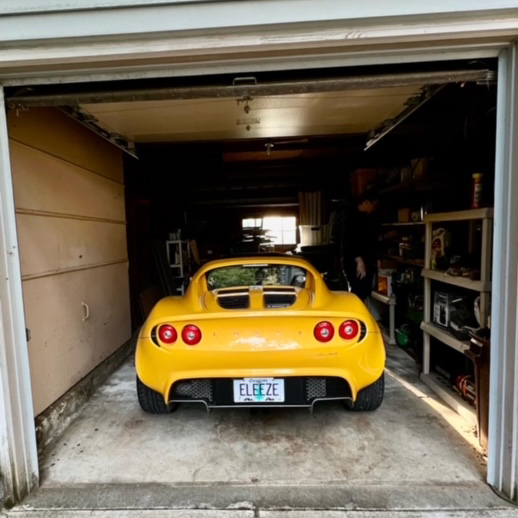
Our 2006 Lotus Elise needs new tires. We’ve covered some of this ground before, but here it is two-and-a-half years later and we have yet to deal with the issue.
The SCM Elise now has about 22,000 miles showing. It has been driven less than 1,000 miles since I suffered my stroke in 2019.
Editor-in-Chief Jeff Sabatini recently put nearly half of those miles on it when he took it to the nearest dealer, Park Place in Seattle. The car’s computer had suffered a glitch and had forgotten its own VIN number, making it impossible to run the car through DEQ.
With that problem solved, and the car now legal to drive, we’re having a chicken-or-the-egg situation.
The Yokohama Advan tires on the car have date-coded out, as the fronts are from 2007 and the rears are from 2010. They are also out-of-round from sitting and a vibration can be felt through through the Elise’s non-assisted steering.
The sidewalls are not cracked and the tires have plenty of tread — that’s not the issue. The car has never been parked outside overnight, and it has spent its life in a climate-controlled garage.
If it is to continue its life mostly sitting parked, there’s little reason to fit new tires. But nobody wants to drive the car in its current state.
Even if we do replace the tires, the car is unlikely to accumulate more than 1,000 miles a year, and I worry that the new tires will also get flat-spotted from sitting in storage.
The good news is that replacement tires have gotten a little more affordable since the last time we looking into it, with a set of four now only about $800, which is 30% less than they were in 2021.
An enormous fog of information and misinformation surrounds the topics of tires and ageing. I thought I would reach out to you for your real-world experiences.
After how many years do you replace your tires? Does it matter if the tires have been shielded from UV light? Do you overinflate your tires before storage? Does it help if you put your tires in little cradles to help keep them from getting flat-spotted? And does the use of nitrogen make any difference?
If you were in my place, and owned a sports car that was being driven less than 1,000 miles a year, how would you manage its tires?
I look forward to hearing your thoughts.


Geez, $800 and the car can be driven at least by someone else. Wouldn’t you feel $800 better knowing your car was in operating condition?
Replace the tires or sell it as they are highly desirable and selling at top dollar. My 2005 Elise has 22,000 miles and I am on my 3rd set of tires. I replace them because they get hard and lose grip, and I am a man of modest means
I couldn’t justify keeping a car that I only drove 1,00 miles a year.
Replace the tires. They’re out of date and everyone is afraid to drive it with the old tires ( I would be too). Driven only 1000 miles in 5 years, it may be time to move on, unless there’s some other issues with the car that prohibits driving.
I live in Florida where I drive my cars all year so I don’t know any tire storage “tricks”, other than continually driving them. Keeping your car on the road cures most, if not all, problems in vintage cars.
If my tires aren’t showing any other issues, I replace them every 7-8 years regardless of mileage. I put at least 3000 miles per year on each car.
For $800 this is a “no-brainer.” Replace the tires. I drive around 3000 miles a year in my 2001 Mercedes SLK320 and replace the tires every 8-10 years despite being stored in a climate controlled garage. This provides peace of mind and the safety, for me and my spouse, is worth every penny.
“Remember, the saddest thing in life is wasted talent. You could have all the talent in the world, but if you don’t do the right thing, then nothing happens. But when you do right, guess what, good things happen.” Lorenzo Anello, A Bronx Tale
Do the right thing Keith… Fit new tires and add “Drive Lotus weekly” to Bradley’s chore chart.
Best of luck and keep the shiny side up.
Keith, it’s possible to have the tires trued. There is at least one shop in my area in MD who do this; I’m sure there is one where you are as well. I would inflate the tires to their maximum and get the car out on a warm day and drive it thirty or forty miles and get the tires hot. They may round out successfully- some do, some don’t. If they don’t, then see if there is a tire dealer who will true them for you. As far as their age, since they’ve been stored indoors and not subject to weathering, don’t worry about it. If they are not weather-checked or hard or otherwise damaged, don’t sweat it.
My daily drivers are outdoors all the time and I worry about aging of their tires. My collector cars are stored indoors and I don’t worry about tire aging.
Just bought a model year 1989 motorcycle with the original 1986 date code tires that had gone 18K miles. They will definitely be replaced before I ride the bike anywhere (even though they are not worn down to the wear bars (ha, ha).
First…Put 10 miles or more on them to see if they just need a good heat cycle to make them round again. Many times, on my car collection after 10 miles all the thumps go away, and the heat makes the tires round again. I learned this from a set of Goodyears I had on my 85 Corvette…once they warmed up, they rolled just fine. My personal choice is to replace them when I am seeing cracking in the tread itself as that is the signal that dry rot has occurred…not based on a date stamp on the tire…as it may have been sitting in a warehouse for a couple of years before it was sold and mounted on the car. I use the date stamp as an indicator but not an absolute.
Seriously? This seems to be a “No Brainer” for a “car guy”…
Spend the $800…
By the way. I live in Beaverton (Close to the Nike Campus) I’d be happy to exercise your car(s) on a regular basis, at no cost to you…
Put it in Alex’s garage and have her drive it. Isn’t she why you are keeping it?
Looks like the jury of your peers has spoken! Yep, replace the tires and if it is not enjoyed for at least 1,000 miles over the next year, sell it off with fresh tires and a nice detail.
Your waiting has already paid you in tire savings and another year will likely be kind to the Elise market, but by then it may be time for another steward. Or not! 🙂 Either way, enjoy the journey.
Hmm, 10 years/10,000 miles. 22 cents a day or 8 cents a mile. Doesn’t sound too expensive this way!
Looks like a no-Breiner to me too. As you likely wont be driving it bargain, it’s time to accept such, sell the car, then and let the new owner put whatever tires he wants on it.
Time to let go, and give somebody else the pleasure of enjoying this great little car.
I have one myself that I need to replace the tires on. Well, actually 2 need tread and both from sitting. One that has been garaged, but is at my family’s place so I can drive something cool when I come to visit. Tires look good, but my last trip in town proved something else, and the other is my blazer that has been in paint and same deal. Tires on the blazer did not even have 100 miles on them when it went in. Now the very last thing that I do.
So, replace so you can share the experience with others….
Require that Bradley and Alex take the cars out every two weeks!
This goes back to the last Blog. Personally I wear out tires. They don’t get a chance to age out. And all I have bought in the last decade or so it Yokohama Advan’s (lowest UTOG#) . You and the kids could get some track days and autocrosses on the Lotus.
In summary – replace tires based on performance and wear. If age were the defining factor then there would be an expiration date and insurance companies would ask for an annual report on the tire age to determine rates.